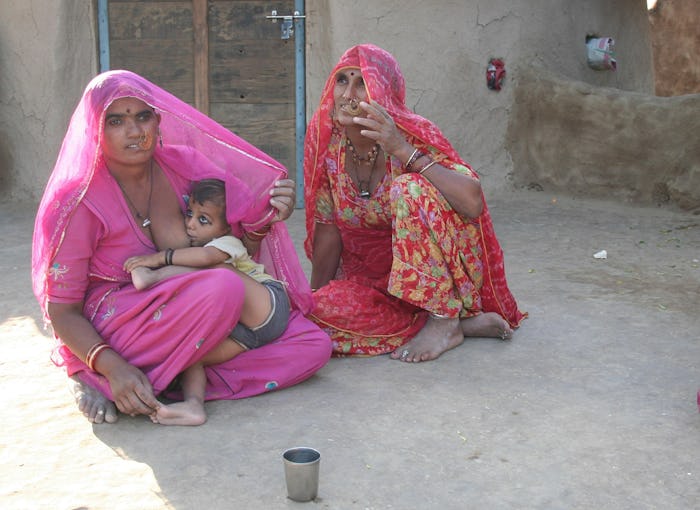Life
What Is Breastfeeding Like In Other Countries? A Look At 6 Places Around The World
The general perception of breastfeeding in the United States has changed dramatically in the last century, and has continued to evolve in our own lifetime. Today, the majority of American mothers are strongly encouraged to breastfeed, not only at birth, but up to a year or longer. Scientific evidence plays a significant role in the public's understanding of the importance of breastfeeding. In fact, moms who can't, or choose not to breastfeed, often feel guilty or ashamed. But, is this feeling exclusive to American moms? What is breastfeeding like in other countries?
According to the Journal of Nutrition, at the turn of the 20th century, close to 70 percent of all mothers in the United States breastfed their children. However, this number began to decline, and by 1972 only 22 percent of American women initiated breastfeeding. The number began to rise in the mid-'70s, dipping again in the early '80s, and growing steadily since. It is believed that the increase was partially related to the move from "twilight sleep" childbirth to epidurals where moms could immediately hold and nurse their children. This was also the time when moms were encouraged to try infant-led nursing rather than adhering to a strict breastfeeding schedule, making the process less stressful to both the mom and baby. Breastfeeding advocacy groups such as La Leche League International (LLLI), also encouraged more moms to initiate breastfeeding.
In other countries, where the amount of education, resources and/or encouragement for breastfeeding mother differs, their practices may differ as well. Here are some ways breastfeeding, and the beliefs and customs surrounding it, varies around the world.
1India
According to LLLI, 95 percent of mothers in India initiate breastfeeding, with 43 percent continuing to nurse for the first four to six months. However, UNICEF estimated that only 46 percent of these children are exclusively breastfed. There is a traditional perception that a mother's colostrum (the nutrient-rich first milk) is "dirty" or "old milk", and in the past was discarded in favor of honey water. Medical professionals are educating Indian mothers on the importance of colostrum.
2Norway
Believe it or not, 99 percent of mothers in Norway initiate breastfeeding, according to LLLI, and 70 percent are still exclusively breastfed at three months. This is likely due to the generous maternity leave laws available to them. Save The Children reported that mothers can take up to 36 weeks off work with 100 percent of their pay, or they may opt to take off 46 weeks with 80 percent pay. Additionally, 80 percent of Norwegian hospitals are considered "baby friendly" meaning that they do not accept free infant formula or bottle-feeding equipment from private companies and have trained staff to help and encourage mothers to breastfeed at birth, according to Public Radio International.
3France
France has historically had one of the lowest percentages of breastfeeding moms. According to LLLI, in 2003 just 50 percent of French mothers initiated breastfeeding. A 2014 report by France’s Institute for Public Health Surveillance stated that less than 25 percent of French babies are breastfed at six months of age. "There is a significant movement in French society which says breastfeeding is tantamount to slavery and exploitation," LLLI spokesperson Claude-Suzanne Didierjean-Jouveau said in an interview with The Local. "So to promote breastfeeding is to be against women’s liberation." LLLI has been trying to change that perception. According to The Local, the number of French moms initiating breastfeeding today is closer to 70 percent.
4Peru
In Peru, 97 percent of newborns are breastfed, according to LLLI. In Culture Parent reported that 69 percent of Peruvian children are breastfed exclusively from birth to five months, and out of these children, 95 percent breastfeed for an average of 20 months. In Peru, breastfeeding is common, and you can often find mothers nursing their children in public without shame or fear.
5Sierra Leone
According to In Culture Parent, only 51 percent of infants in Sierra Leone are breastfed at birth, and just 11 percent are exclusively breastfed in the first five months of life. UNICEF reported that the long-held beliefs that breast milk is not enough food for a baby and that colostrum is poisonous has been a factor in these low numbers. Sierra Leone has among the highest infant mortality rates in the world and the lowest rates of exclusive breastfeeding. The country has even held "pageants" in which children who are exclusively breastfed for at at least six months can compete for "healthiest baby" in order to promote breastfeeding.
6Morocco
LLLI reported that 95 percent of moms in Morocco initiated breastfeeding, however, according to only 31 percent of babies are exclusively breastfed from birth to five months, and of those children 57 percent continue to breastfeed to 12 to 15 months of age. Breastfeeding is highly regarded in Islam, in fact, children who breastfeed from the same wet-nurse are considered siblings (even if no blood relation exists) and are forbidden from marrying each other, according to Islamic Garden.
